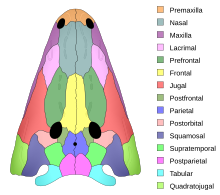Temnospondyli
Temnospondyli (from Greek τέμνειν, temnein 'to cut' and σπόνδυλος, spondylos 'vertebra') is a diverse order of small to giant tetrapods—often considered primitive amphibians—that flourished worldwide during the Carboniferous, Permian, and Triassic periods. A few species continued into the Jurassic and Cretaceous periods. Fossils have been found on every continent. During about 210 million years of evolutionary history, they adapted to a wide range of habitats, including fresh water, terrestrial, and even coastal marine environments. Their life history is well understood, with fossils known from the larval stage, metamorphosis, and maturity. Most temnospondyls were semiaquatic, although some were almost fully terrestrial, returning to the water only to breed. These temnospondyls were some of the first vertebrates fully adapted to life on land. Although temnospondyls are considered amphibians, many had characteristics, such as scales, claws, and armour-like bony plates, that distinguish them from modern amphibians.
Temnospondyls have been known since the early 19th century, and were initially thought to be reptiles. They were described at various times as batrachians, stegocephalians, and labyrinthodonts, although these names are now rarely used. Animals now grouped in Temnospondyli were spread out among several amphibian groups until the early 20th century, when they were found to belong to a distinct taxon based on the structure of their vertebrae. Temnospondyli means "cut vertebrae", as each vertebra is divided into several parts.
Experts disagree over whether temnospondyls were ancestral to modern amphibians (frogs, salamanders, and caecilians), or whether the whole group died out without leaving any descendants. Different hypotheses have placed modern amphibians as the descendants of temnospondyls, another group of early tetrapods called lepospondylis, or even as descendants of both groups (with caecilians evolving from lepospondyls and frogs and salamanders evolving from temnospondyls). Recent studies place a family of temnospondyls called the amphibamids as the closest relatives of modern amphibians. Similarities in teeth, skulls, and hearing structures link the two groups.
Many temnospondyls are much larger than living amphibians, and superficially resemble crocodiles. Others are smaller and resemble salamanders.[1] Most have broad, flat heads that are either blunt (brevirostrine) or elongated (longirostrine). The skulls are rounded or triangular in shape when viewed from above, and are usually covered in pits and ridges. The rugged surfaces of bones may have supported blood vessels, which could transfer carbon dioxide to the bones to neutralize acidic build up in the blood (early semiaquatic tetrapods would have had difficulty expelling carbon dioxide from their bodies while on land, and these dermal bones may have been an early solution to the problem).[2] Many temnospondyls also have canal-like grooves in their skulls called sensory sulci. The sulci, which usually run around the nostrils and eye sockets, are part of a lateral line system used to detect vibrations in water.[1] As semiaquatic animals, all known temnospondyls have small limbs with no more than four toes on each front foot and five on each hind foot.[3] Terrestrial temnospondyls have larger, thicker limbs, and some even have claws.[4] One unusual terrestrial temnospondyl, Fayella, has relatively long limbs for its body, and probably lived as an active runner able to chase prey.[5]



.JPG/440px-Sclerocephalus_(Actinodon).JPG)
